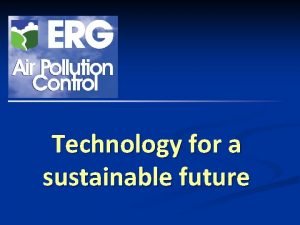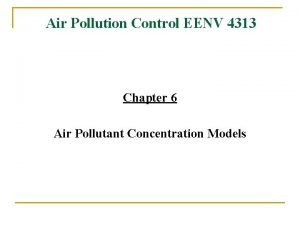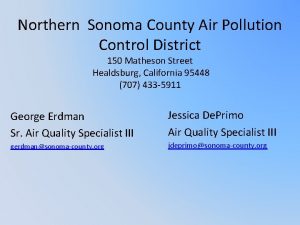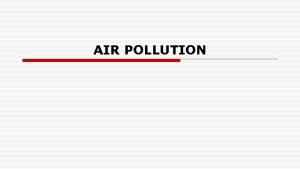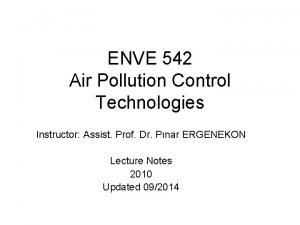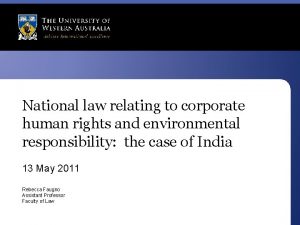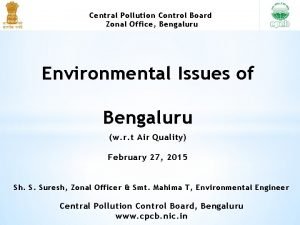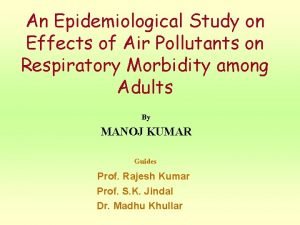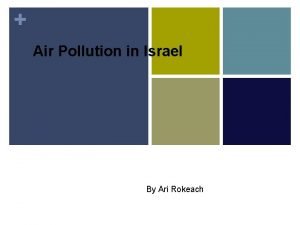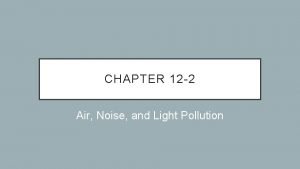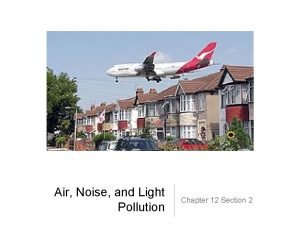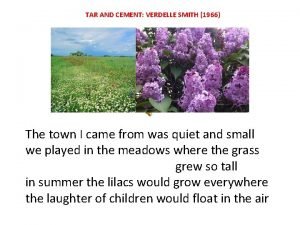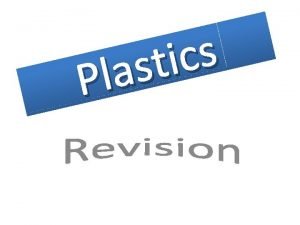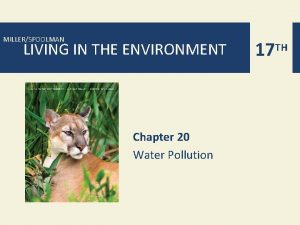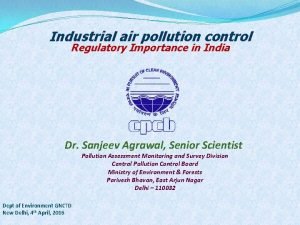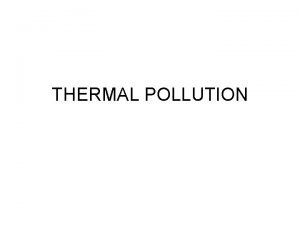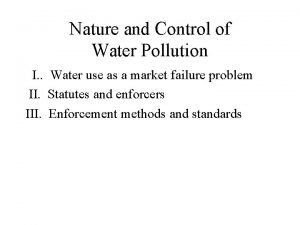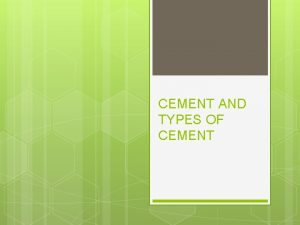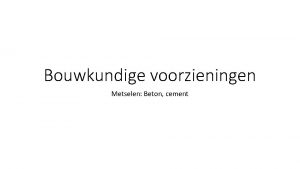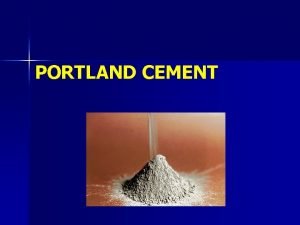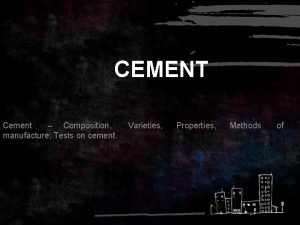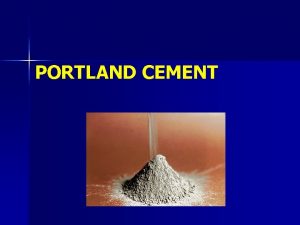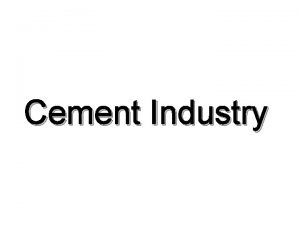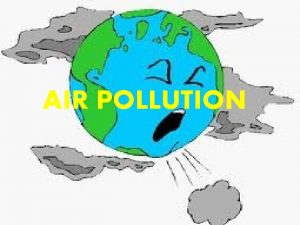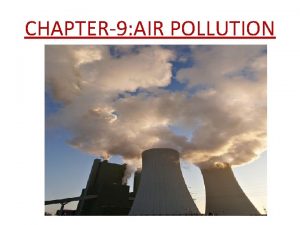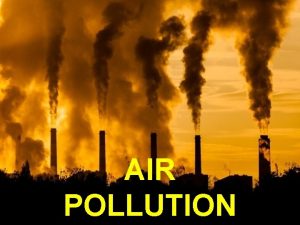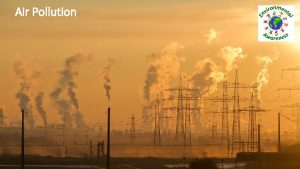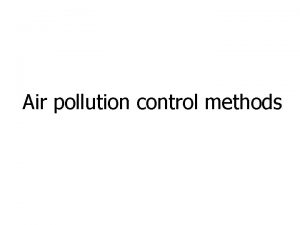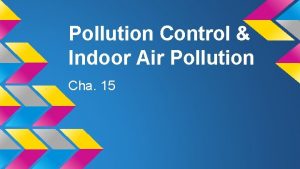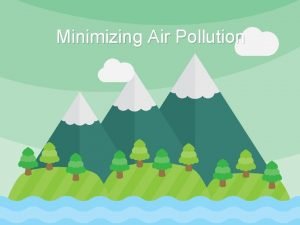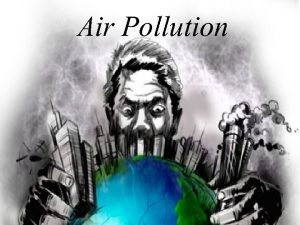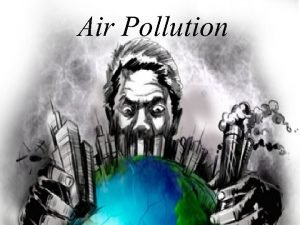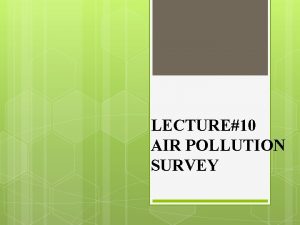AIR POLUTION AND AIR POLLUTION CONTROL IN CEMENT


























- Slides: 26

AIR POLUTION AND AIR POLLUTION CONTROL IN CEMENT INDUSTRY

Cement Industry Cement manufacturing involves mining; crushing, and grinding of raw materials; calcination in a rotary/vertical kiln; cooling of the clinker; mixing with gypsum; and milling, storing, and bagging the finished cement. The process is very energy-intensive. Gases from kiln and clinker cooler are used to preheat combustion air and also to generate power. Solid waste products from other industries, such as fly ash , slag, roasted pyrite residues, and foundry sand, are used as additives in cement production.

Flow Sheet Cement Manufacturing Process

Pollution Prevention and Control Cement industry’s focus is on reducing ambient particulate emission by reducing the mass load emitted from the stacks, and other sources up to less than 0. 2 kilograms of dust per metric ton (kg/t) of clinker using dust recovery systems. NOx emissions are controlled using proper kiln design, low-NOx burners, and an optimum level of excess air. NOx emissions are typically 1. 5 kg/t of clinker. The nitrogen oxide emissions can be reduced further, to 0. 5 kg/t of clinker, by after- burning in a reducing atmosphere, and the energy of the gases can be recovered in a preheater/ precalciner. This is done using SCR? NSCR technology.

Pollution Prevention and Control SOx emissions are best controlled by using low- sulfur fuels and raw materials. SO 2 emissions is not a serius issue as the “S” compounds in flue gases react with Lime in cement and get a trapped in cement. The lime content of raw materials can be used to control sulfur oxides. Alkaline dust removed from the kiln gases is normally disposed of as solid waste. When solid wastes such as pulverized fly ash are used with feedstock, appropriate steps are taken to avoid environmental problems from contaminants or trace elements.

Pollution Prevention and Control ESPs and Bag houses can achieve high levels of particulate removal from the kiln gas stream, but good operation and maintenance are essential for achieving design specifications. Two significant types of control problem can occur: (a) complete failure (or automatic shutoff) of systems related to plant shutdown and start-up, power failures, and the like, leading to emission of very high levels of particulates for short periods of time; and (b) a gradual decrease in the removal efficiency of the system over time because of poor maintenance or improperation.

Air Emissions A maximum emissions level of 30 milligrams per normal cubic meter (mg/Nm 3), equivalent to a maximum of 0. 125 kg/t of clinker, for particulates in stack gases under full-load conditions is to be achieved. This emissions level is based on values that are routinely achieved in well-run plants. Maximum emissions levels for sulfur oxides are 100 mg/Nm 3; for nitrogen oxides, 500 mg/Nm 3.

Effluent Guidelines Liquid Effluents Normally, effluents requiring treatment originate from cooling operations or as mine drainage or storm water. Treated effluent discharges should have a p. H in the range of 6– 9. Cooling water should preferably be recycled. If this is not economical the effluent should not increase the temperature of the receiving waters at the edge of the mixing zone (or 100 meters, where the mixing zone is not defined) by more than 5° Celsius. If quantities of suspended solids in the effluent are high in relation to receiving waters, treatment may be required to reduce levels in the effluent to a maximum of 50 milligrams per liter (mg/l).

Noise abatement measures should achieve either the levels given below or a maximum increase in background levels of 3 decibels (measured on the A scale) [d. B (A)]. Measurements are to be taken at noise receptors located outside the project property boundary. Residential, 55 d. B day time and 45 Night Time; institutional, Industrial, and commercial 70 both day and night

Monitoring and Reporting Continuous monitoring System on stacks/chimneys should be installed. Measurement of the sulfur content of raw materials and fuel, and direct measurement of particulate, SOx, and NOx levels at the plant boundary levels, should be carried out periodically. The TSS, p. H and temperature of the wastewater be monitored on a continuous basis. Monitoring data should be analyzed and reviewed and compared with the operating standards. Records of monitoring results should be kept in an acceptable format. The results should be reported to the responsible authorities and relevant parties, as required. .

Control Technology Install equipment covers and filters for crushing, grinding, and milling operations. Use enclosed adjustable conveyors to minimize drop distances. Wet down intermediate and finished product storage piles. Use low-NOx burners with the optimum level of excess air. Use low sulfur fuels in the kiln. Operate control systems to achieve the required emissions levels. Develop a strong unit or division to undertake environmental management responsibilities. Use Alternate Fuels!!

THERMAL POWER PLANTS

Waste Characteristics The wastes generated by TPP are from combustion processes. The exhaust gases from burning coal and oil contain primarily particulates (including heavy metals, if they are present in significant concentrations in the fuel), sulfur and nitrogen oxides (SOx and NOx), and volatile organic compounds (VOCs). A 500 MW power plant using coal with 2. 5% sulfur (S), 16% ash, and 30, 000 kilojoules per kilogram (k. J/kg) heat content will emit each day 200 metric tons of sulfur dioxide (SO 2), 70 tons of nitrogen dioxide (NO 2), and 500 tons of fly ash if no controls are present. In addition, the plant will generate about 500 tons of solid waste and about 17 GWh of thermal discharge.

Waste Characteristics Steam turbines and other equipment may require large quantities of water for cooling, including steam condensation. Water is also required for auxiliary station equipment, ash handling, and FGD systems. The characteristics of the wastewaters generated depend on the ways in which the water has been used. Contamination arises from demineralizers, lubricating and auxiliary fuel oils, and chlorine, biocides, and other chemicals used to manage the quality of water in cooling systems. Once-through cooling systems increase the temperature of the receiving water.

Emission Guidelines Particulate matter PM emissions (all sizes) should not exceed 30 mg/Nm 3. Epidemiologic evidence suggests that much of the health damage caused by exposure to particulates is associated with fine particles, which penetrate most deeply into the lungs. Emissions of PM 10 and fine particulates include ash, soot, and carbon compounds (often the results of incomplete combustion), acid condensates, sulfates, and nitrates, as well as lead, cadmium, and other metals.

Emission Guidelines Sulfur dioxide Total sulfur dioxide emissions from the power plant or unit should be less than 0. 20 metric tons per day (tpd) per MW of capacity for the first 500 MW, plus 0. 10 tpd for each additional MW of capacity over 500 MW. In addition, the concentration of sulfur dioxide in flue gases should not exceed 2, 000 mg/Nm 3, with a maximum emissions level of 500 tpd. Construction of two or more separate plants in the same air shed to circumvent this cap is not acceptable.

Emission Guidelines Nitrogen oxides The specific emissions limits for nitrogen oxides are 750 mg/Nm 3, or 260 nano grams per joule (ng/J), or 365 parts per million parts (ppm) for a coal-fired power plant, and up to 1, 500 mg/Nm 3 for plants using coal with volatile matter less than 10%; 460 mg/Nm 3 (or 130 ng/J, or 225 ppm) for an oil-fired power plant; and 320 mg/ Nm 3 (or 86 ng/J, or 155 ppm) for a gas-fired power plant. For combustion turbine units, the maximum NOx emissions levels are 125 mg/Nm 3 (dry at 15% oxygen) for gas; 165 mg/Nm 3 (dry at 15% oxygen) for diesel (No. 2 oil); and 300 mg/Nm 3 (dry at 15% oxygen) for fuel oil (No. 6 and others). Where there are technical difficulties, such as scarcity of water available for water injection, an emissions variance allowing a maximum emissions level of up to 400 mg/Nm 3 dry (at 15% oxygen) is considered acceptable, provided there are no significant environmental concerns associated with ambient levels of ozone or nitrogen dioxide.

Emission Guidelines Liquid Effluents Parameter Maximum value p. H 6– 9 TSS 50 Oil and grease 10 Total residual chlorine 0. 2 Chromium (total) 0. 5 Copper 0. 5 Iron 1. 0 Zinc 1. 0

Emission Guidelines Solid wastes, including ash and FGD sludge that do not leach toxic substances or other contaminants of concern to the environment may be disposed in landfills or other disposal sites provided that they do not impact nearby water bodies. Where toxics or other contaminants are expected to leach out, they should be treated by, for example, stabilization before disposal. Ambient Noise Day Receptor (07: 00– 22: 00) Night (22: 00– 07: 00) Residential, institutional, Educational 55 45 70 70 Industrial, Commercial

Monitoring and Reporting • Particulate matter. Ash and heavy metal content of fuel; maximum flue gas flow rate; minimum power supply to the ESP or minimum pressure drop across the bag house; minimum combustion temperature; and minimum excess oxygen level. • Sulfur dioxide. Sulfur content of fuel. • Nitrogen oxides. Maximum combustion temperature and maximum excess oxygen level

Monitoring and Reporting Measurement of emissions in samples of flue gases should be performed regularly. The samples should be monitored for PM and nitrogen oxides and for sulfur oxides and heavy metals. Automatic air quality monitoring systems measuring ambient levels of PM 10, sulfur oxides, and nitrogen oxides outside the plant boundary should be installed where maximum ambient concentration is expected or where there are sensitive receptors such as protected areas and population centers. The number of air quality monitors should be greater if the area in which the power plant is located is prone to temperature inversions or other meteorological conditions that lead to high levels of air pollutants affecting nearby populations or sensitive ecosystems

Monitoring and Reporting The p. H and temperature of the wastewater discharges should be monitored continuously. Levels of suspended solids, oil and grease, and residual chlorine should be measured daily, and heavy metals and other pollutants in wastewater discharges should be measured monthly if treatment is provided Monitoring data should be analyzed and reviewed at regular intervals and compared with the operating standards so that any necessary corrective actions can be taken. Records of monitoring results should be kept in an acceptable format. The GHG emissions of individual projects should be estimated on the basis of the chemical composition of the fuel or measured directly.

Prevention and Control of Pollution Choose the cleanest fuel economically available (natural gas is preferable to oil, which is preferable to coal). Give preference to high-heat-content, low-ash, low-sulfur coal (or high-heat-content, high- sulfur coal, in that order) and consider beneficiation for high-ash, high-sulfur coal. Select the best power generation technology for the fuel chosen to balance the environmental and economic benefits. The choice of technology and pollution control systems will be based on the site-specific environmental assessment.

Prevention and Control of Pollution Keep in mind, particulates smaller than 10 microns in size are most important from a health perspective. Acceptable levels of particulate matter removal are achievable at relatively low cost. Consider cost-effective technologies such as pre-ESP sorbent injection, along with coal washing, before in-stack removal of sulfur dioxide. Use low-NOx burners and other combustion modifications to reduce emissions of nitrogen oxides. Before adopting expensive control technologies, consider using offsetting reductions in emissions of critical pollutants at other sources within the air shed to achieve acceptable ambient levels.

Prevention and Control of Pollution Use SOx removal systems that generate less wastewater, if feasible; however, the environ-mental and cost characteristics of both inputs and wastes should be assessed case by case. Manage ash disposal and reclamation so as to minimize environmental impacts—especially the migration of toxic metals, if present, to nearby surface and groundwater bodies, in addition to the transport of suspended solids in surface runoff. Consider reusing ash for building materials. Consider recirculating cooling systems where thermal discharge to water bodies may be of concern.

AIR POLLUTION CONTROL TECHNOLOGIES THANKS
 Consequences of soil pollution
Consequences of soil pollution Erg (air pollution control) ltd
Erg (air pollution control) ltd Air pollution box model example
Air pollution box model example Northern sonoma county air pollution control district
Northern sonoma county air pollution control district Air pollution control methods
Air pollution control methods Air pollution control technology
Air pollution control technology Chapter 12 section 1
Chapter 12 section 1 Chapter 12 air section 1 what causes air pollution
Chapter 12 air section 1 what causes air pollution Central and state pollution control board
Central and state pollution control board Functions of pollution control board
Functions of pollution control board 2 causes of land pollution
2 causes of land pollution Soil pollution images diagram
Soil pollution images diagram Aim or objectives of air pollution
Aim or objectives of air pollution Secondary air pollutant example
Secondary air pollutant example Ari rokeach
Ari rokeach Baghouse filter definition apes
Baghouse filter definition apes Air noise and light pollution
Air noise and light pollution Section 2 air noise and light pollution
Section 2 air noise and light pollution Air higroskopis adalah
Air higroskopis adalah Tar and cement
Tar and cement Melamine formaldehyde advantages and disadvantages
Melamine formaldehyde advantages and disadvantages How to reduce water pollution
How to reduce water pollution Air pollutant definition
Air pollutant definition Thermal pollution control
Thermal pollution control Air pollution consequences
Air pollution consequences Sources of thermal pollution
Sources of thermal pollution Control measures of water pollution ppt
Control measures of water pollution ppt

